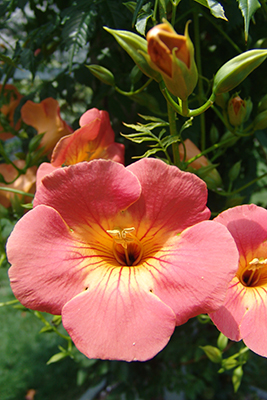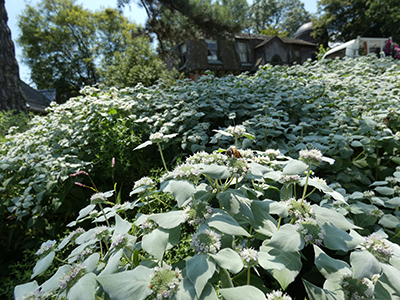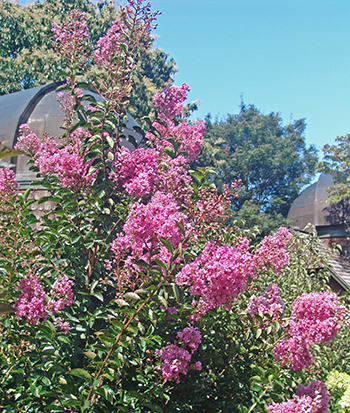
Plants of the Week: July 22
Guest Author: Rosemary Grogan, 2019 summer intern

Campsis grandiflora ‘Morning Calm’
If you take a walk through the Isabelle Cosby Courtyard, you will find striking, reddish-orange flowers towering overhead. Campsis grandiflora ‘Morning Calm’ is a climbing vine that produces trumpet-shaped blooms perfect for hummingbirds starting in early June and continuing in cycles throughout the duration of the summer. The serrated foliage is medium to dark.
The vine can reach an impressive 20 to 30 feet tall and 6 to 9 feet wide. Also known as the Chinese trumpetcreeper, Campsis grandiflora is less vigorous than its native counterpart Campsis radicans.
Photo Credit: A Bunting

Pycnanthemum muticum
Under the Pinus nigra near the Wister Center and Cunningham House you will find massive, silvery bushes of Pycnanthemum muticum. The plant’s given name suggests its appearance, originating from the Greek pyknos meaning dense and anthos meaning flower. Pycnanthemum muticum, or clustered mountainmint, is native to eastern North America where it naturally appears in meadows and other grassy areas.
Look closely and you will see plenty of pollinators flying around the clumps of flowers that have touches of pink. Smell the leaves and you will notice a robust mint smell, resembling peppermint. Photo Credit: R.Grogan

Lagerstroemia ‘Sioux’
Near the Cunningham House you will find multiple Lagerstroemie ‘Sioux’ intermixed between other colorful foliage. A classic identifying feature of Lagerstroemia, or crapemyrtle, is its smooth, peeling bark. What sets this cultivar apart from the others is its vibrant pink flowers over dark green foliage. This contrast immediately catches your attention.
This specific cultivar blooms from July to August, while its leaves will transition to maroon in the fall. It is among one of the longest blooming deciduous trees, lasting as long as 120 days. As the common name would suggest, the flowers have a ruffled texture that shares visual characteristics of the popular party decoration, crepe paper.
Photo Credit: R. Robert





No Comments